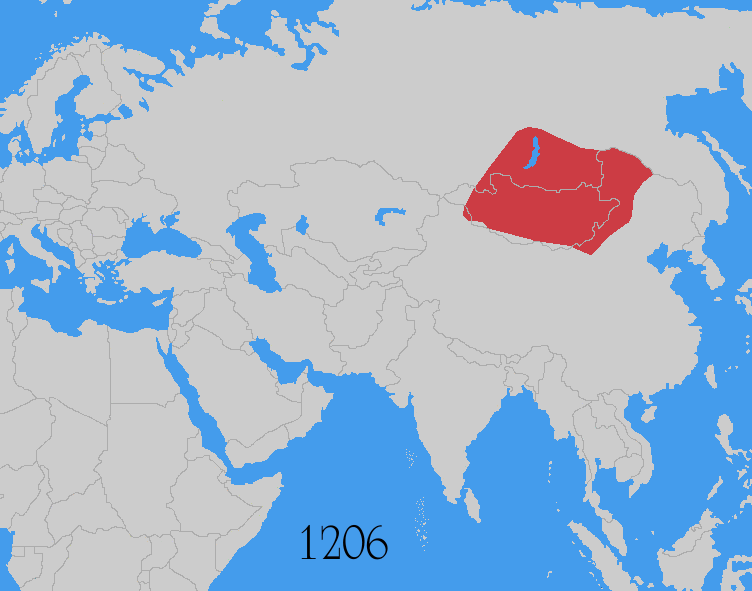
("Mongol Empire map" by User:Astrokey44 - Based on the freely licenced Image:Genghis khan empire at his death.png using information from maps of the Mongol Empire in atlases and on the web such as [1], [2], [3], [4], [5]. Made in Photoshop and Painter.. Licensed under CC BY-SA 3.0 via Wikimedia Commons.)
It's fairly safe to say "Mongolian Wrestling" (also known as "Bokh,") influenced Shoulin Kung Fu far more than the other way around. For example, it seems likely that the ubiquitous "horse stance" found in almost all East Asian martial arts originated with the Mongols, since the average Mongolian warrior rode a horse all the time, unlike the average Shoulin monk.
In Bokh the goal is to get opponents to touch the ground with any part of the body besides the hands or feet. Coming from a herding and hunting culture, they aren't concerned about territory control or fighting indoors and thus have an unlimited ring size (unlike the Chinese Lei Tai elevated fighting platform/stage) :
In "Choosing a Martial Art" I use a story of a hypothetical village where Mongolian Wrestling starts an evolution of martial arts that explains the various categories of martial arts we encounter. However another way of using Bokh to look at martial arts, is as all other martial arts being a reaction to Bokh. Considering how wide spread exposure to Bokh must have been in the past, this is historically true to varying degrees. Chinese Wrestling is clearly Mongolian Wrestling for those not tough enough to be real Mongolians:
In the internal martial arts push hands sparring (not to be confused with stationary push hands drills,) is very similar to Bokh in it's rules. In some regions Mongolian Wrestling does not allow an opponents hand to touch the ground. Add to that the Lei Tai concept and we have push hands sparring (one obvious connection was the founder of the largest sect of Taoism today was a friend of Genghis Khan):
In the west, the ancient art of Glima bears a strong resemblance to Mongolian Wrestling as well:
The Mongolian Wrestling approach to self-defense works well for warriors because putting an attacker down on the battle field gives you time to draw your own weapon and finish your enemy off before he returns to his feet. Also compared to the injury risk of trading blows and wrestling for submission holds, there is a very high return on skill and physical conditioning for warriors using Mongolian Wrestling as a way to stay combat ready. As the Vikings played a similar role in Europe as the Mongolians did in Asia, it makes sense that the Vikings had a similar martial art very much like Mongolian Wrestling.
Besides imitating Mongolian Wrestling, other martial arts go for more expansive or simply completely different techniques, in hopes they can out strategize what essentially amounts to a Mongolian Wrestler. So many self defense techniques are focused on what to do if someone grabs you like a competent stand up grappler... and in the context of these martial arts origins, it seems like someone was worried about self defense against a Mongolian Wrestler. Weapon martial arts are again trying to give the advantage against the historical bully and dominant fighter on the battlefield:
And as you can see from that video, even when techniques vary, the objective of martial arts is often the same: to put the opponent on the ground. The ultimate goal of any type of boxing or kick boxing is to put the opponent on the ground, and in traditional full contact "knock down" Karate, it is the only way to score. Even as far off as the UK, "shin kicking" players have identical goals to Bokh players:
Now even Japanese Judo (and to some degree Sumo) with all their starchy traditions, self-righteous espoused values and convenient culturally biased changes to their rules, can't avoid the inevitable influence of Bokh (as if Bokh's influence on these sports wasn't already obvious enough):
Like the universal influence of the ancient Mongolian Hordes, the influence of Bokh on martial arts is felt today all over the world.
(October 2015 update: check out my newer post on the importance of wrestling to martial arts in terms of history, religion and technique.)